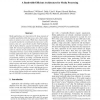Free Online Productivity Tools
i2Speak
i2Symbol
i2OCR
iTex2Img
iWeb2Print
iWeb2Shot
i2Type
iPdf2Split
iPdf2Merge
i2Bopomofo
i2Arabic
i2Style
i2Image
i2PDF
iLatex2Rtf
Sci2ools
MICRO
1998
IEEE
1998
IEEE
A Bandwidth-efficient Architecture for Media Processing
Media applications are characterized by large amounts of available parallelism, little data reuse, and a high computation to memory access ratio. While these characteristics are poorly matched to conventional microprocessor architectures, they are a good fit for modern VLSI technology with its high arithmetic capacity but limited global bandwidth. The stream programming model, in which an application is coded as streams of data records passing through computation kernels, exposes both parallelism and locality in media applications that can be exploited by VLSI architectures. The Imagine architecture supports the stream programming model by providing a bandwidth hierarchy tailored to the demands of media applications. Compared to a conventional scalar processor, Imagine reduces the global register and memory bandwidth required by typical applications by factors of 13 and 21 respectively. This bandwidth efficiency enables a single chip Imagine processor to achieve a peak performance of ...
Related Content
| Added | 05 Aug 2010 |
| Updated | 05 Aug 2010 |
| Type | Conference |
| Year | 1998 |
| Where | MICRO |
| Authors | Scott Rixner, William J. Dally, Ujval J. Kapasi, Brucek Khailany, Abelardo López-Lagunas, Peter R. Mattson, John D. Owens |
Comments (0)

